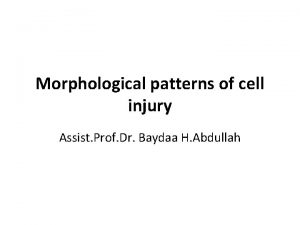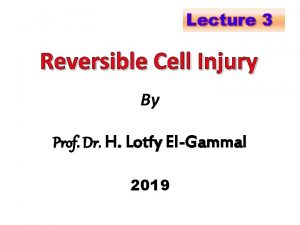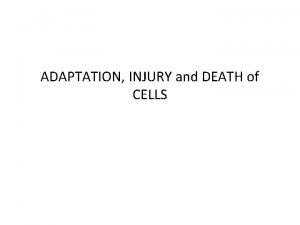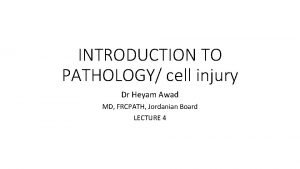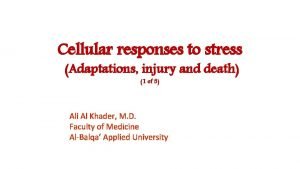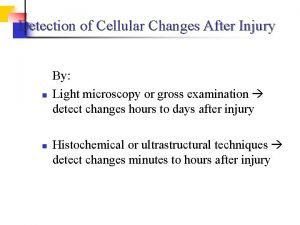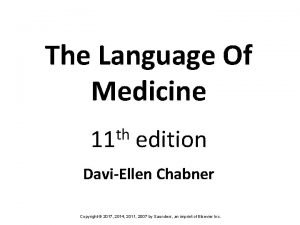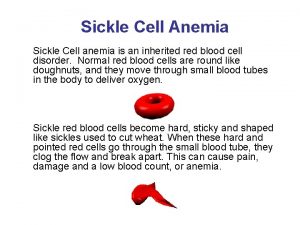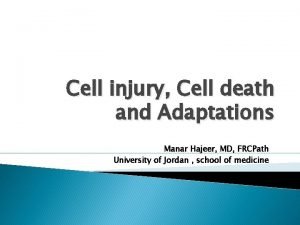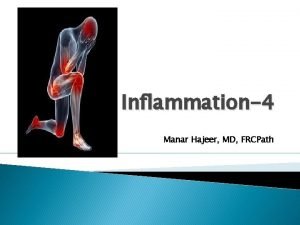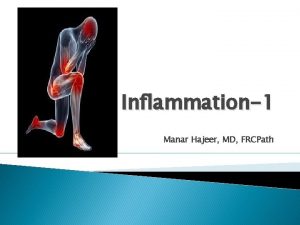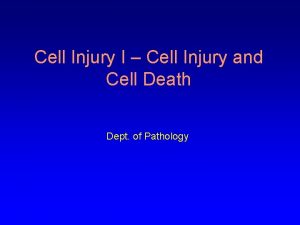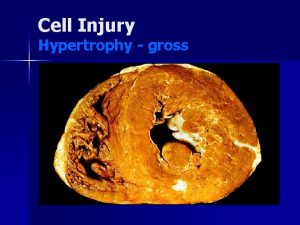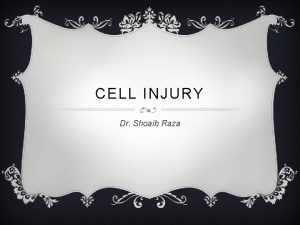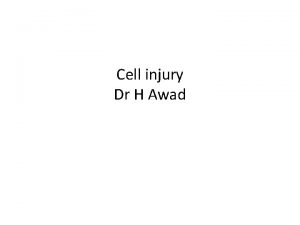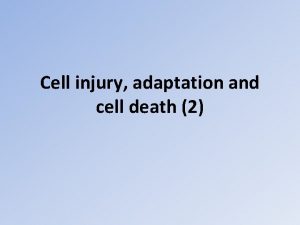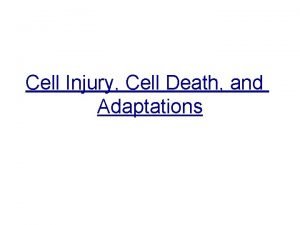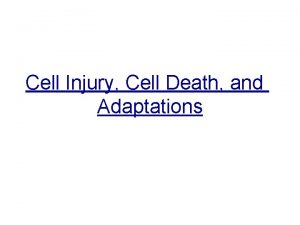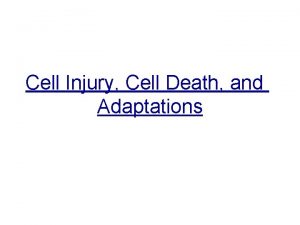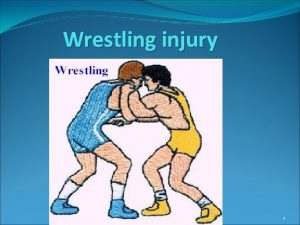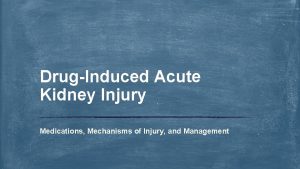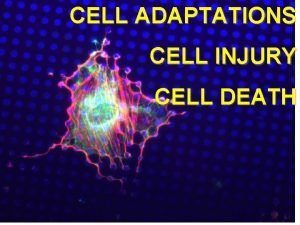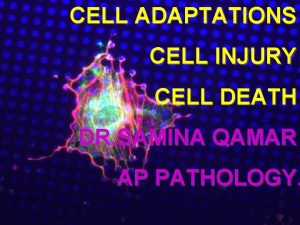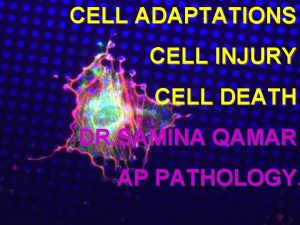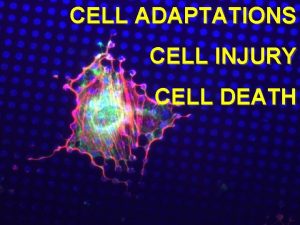CAUSES AND MECHANISMS OF CELL INJURY Manar Hajeer




























- Slides: 28

CAUSES AND MECHANISMS OF CELL INJURY Manar Hajeer, MD, FRCPath.

Causes of cell injury Ø Oxygen Deprivation (Hypoxia Vs ischemia) Ø Chemical Agents Ø Infectious Agents Ø Immunologic Reactions Ø Genetic Factors Ø Nutritional Imbalances Ø Physical Agents Ø Aging

Oxygen Deprivation

Chemical Agents

Infectious Agents

Immunologic Reactions

Genetic Factors

Nutritional Imbalances

Physical Agents

MECHANISMS OF CELL INJURY � � Principles The cellular response to injury depends on: type of injury duration severity The consequences of injury depend on: type, status, adaptability, and genetic makeup of the injured cell Cell injury results from functional and biochemical abnormalities in one or more of several essential cellular components

The principal targets of cell injury are:

Depletion of ATP

Significant depletion of ATP has widespread effects on many critical cellular systems � Plasma membrane ATP-dependent sodium pumps � Increase in anaerobic glycolysis � Failure of ATP-dependent Ca pumps leads to influx of Ca. � Structural disruption of the protein synthetic apparatus. � Irreversible damage to mitochondrial and lysosomal membranes, leading to necrosis.

Mitochondrial Damage and Dysfunction

Mitochondrial damage may result in several biochemical abnormalities � Progressive depletion of ATP, � Formation of reactive oxygen species � Formation of a high-conductance channel in the mitochondrial membrane (mitochondrial permeability transition pore) � Released of certain proteins into the cytoplasm to activate apoptosis

Influx of Calcium

� Sources of intracellular calcium: Intracellular stores (mitochondria and ER) Influx across plasma membrane(ATP dependent). � Increased cytosolic Ca activates a number of enzymes, � Calcium induces apoptosis by Direct activation of caspases Increasing mitochondrial permeability

Accumulation of Oxygen-Derived Free Radicals (Oxidative Stress)

Free radicals � Chemical species with single unpaired electron (extremely unstable) � Attack nucleic acids, cellular proteins and lipids. � Molecules that react with free radicals are converted into free radicals. � Involved in: ischemia-reperfusion, chemical and radiation injury, toxicity from oxygen , cellular aging, microbial killing by phagocytes, and tissue injury in inflammation. � The damage caused by them is determined by their rates of production and removal

ROS are produced by two major pathways � Normally in small amounts in all cells during (redox) reactions in the mitochondria. � In phagocytic leukocytes (neutrophils and macrophages) for destroying microbes and inflammatory reactions.


� Generation of free radicals � Radiant energy � Exogenous chemicals � Inflammation � Removal of free radicals: � SPONTANIOUS DECAY � Superoxide dismutases (SODs) � Glutathione (GSH) peroxidases. � Catalase. � Endogenous or exogenous antioxidants (vitamins E, A, and C and β-carotene

Defects in Membrane Permeability Cell membranes, lysosomal membranes, mitochondrial membranes.

Damage to DNA and Proteins � Cells have mechanisms that repair damage to DNA. � If damage is too severe, trigger apoptosis. � Improperly folded proteins have similar effect

CLINICOPATHOLOGIC CORRELATIONS: EXAMPLES OF CELL INJURY AND NECROSIS � Ischemic � � � and Hypoxic Injury Ischemia injures tissues faster than hypoxia Reduced generation of ATP Functional consequences (heart muscle) If oxygen is restored, disturbances are reversible. If ischemia persists, irreversible injury and necrosis.


Ischemia-Reperfusion Injury � Restoration of blood flow to ischemic but viable tissues results, in the death of cells that are reversibly injured. � Mechanism: � By generation of ROS from parenchymal, endothelial cells and leukocytes � By influx of leukocytes and plasma proteins (complement)

Chemical (Toxic) Injury � Direct toxicity: combining molecular component or cellular organelle � Examples: mercuric chloride poisining (seafood), chemotherapeutic drugs. � Indirect toxicity: converted to reactive toxic metabolites, involves the formation of free radicals. (cytochrome P-450) � Examples: Carbon tetrachloride (CCl 4), acetaminophen
 Types of necrosis
Types of necrosis Intentional injury
Intentional injury Cell injury and inflammation
Cell injury and inflammation Dry gangrene vs wet gangrene
Dry gangrene vs wet gangrene Mucoid change in reversible cell injury
Mucoid change in reversible cell injury Cellular adaptation
Cellular adaptation Myelin figures in reversible cell injury
Myelin figures in reversible cell injury Example of physiological hyperplasia
Example of physiological hyperplasia Reversible cell injury
Reversible cell injury Proximate cause and ultimate cause
Proximate cause and ultimate cause Proximate behaviour in animals
Proximate behaviour in animals What causes cell
What causes cell Anemia structure
Anemia structure Denuding tower
Denuding tower Linear chromosomes in eukaryotes
Linear chromosomes in eukaryotes Animal and plant cell venn diagram
Animal and plant cell venn diagram Vacuole function
Vacuole function Endoplasmic reticulum function
Endoplasmic reticulum function Lead acid battery primary or secondary
Lead acid battery primary or secondary Difference between bacteria and plant cell
Difference between bacteria and plant cell Events of the cell cycle
Events of the cell cycle Life
Life The scientist mathias schleiden studied _______ in ______.
The scientist mathias schleiden studied _______ in ______. Idealized plant cell
Idealized plant cell Walker cell and hadley cell
Walker cell and hadley cell Cell cycle and cell division
Cell cycle and cell division Plant animal cell venn diagram
Plant animal cell venn diagram Cell cycle and cell division
Cell cycle and cell division Voltaic vs electrolytic cell
Voltaic vs electrolytic cell



